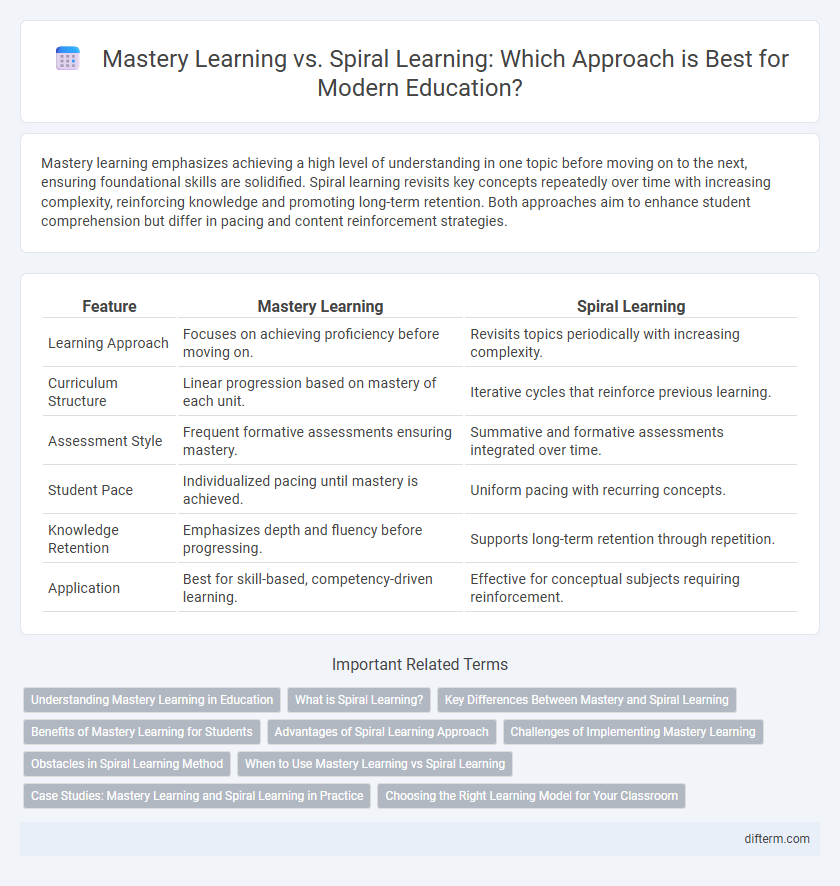Mastery learning emphasizes achieving a high level of understanding in one topic before moving on to the next, ensuring foundational skills are solidified. Spiral learning revisits key concepts repeatedly over time with increasing complexity, reinforcing knowledge and promoting long-term retention. Both approaches aim to enhance student comprehension but differ in pacing and content reinforcement strategies.
Table of Comparison
| Feature | Mastery Learning | Spiral Learning |
|---|---|---|
| Learning Approach | Focuses on achieving proficiency before moving on. | Revisits topics periodically with increasing complexity. |
| Curriculum Structure | Linear progression based on mastery of each unit. | Iterative cycles that reinforce previous learning. |
| Assessment Style | Frequent formative assessments ensuring mastery. | Summative and formative assessments integrated over time. |
| Student Pace | Individualized pacing until mastery is achieved. | Uniform pacing with recurring concepts. |
| Knowledge Retention | Emphasizes depth and fluency before progressing. | Supports long-term retention through repetition. |
| Application | Best for skill-based, competency-driven learning. | Effective for conceptual subjects requiring reinforcement. |
Understanding Mastery Learning in Education
Mastery Learning in education emphasizes achieving a high level of understanding before progressing to new concepts, ensuring students master foundational skills thoroughly. This approach promotes personalized pacing and frequent formative assessments to identify and address learning gaps effectively. Unlike Spiral Learning, which revisits topics periodically, Mastery Learning prioritizes depth and competency in each topic before advancing.
What is Spiral Learning?
Spiral learning is an instructional approach where key concepts are revisited and expanded upon over time, allowing students to build deeper understanding through repeated exposure at increasing levels of complexity. This method contrasts with mastery learning by emphasizing cumulative knowledge growth rather than complete mastery before advancing. Spiral learning supports long-term retention by reinforcing earlier learned content while integrating new information in a structured sequence.
Key Differences Between Mastery and Spiral Learning
Mastery Learning emphasizes complete proficiency in one topic before progressing, ensuring students achieve a high level of understanding and skill. Spiral Learning revisits topics periodically at increasing levels of complexity, reinforcing knowledge through repeated exposure over time. The key difference lies in Mastery Learning's focus on mastery before advancement, while Spiral Learning builds knowledge incrementally through cyclical review.
Benefits of Mastery Learning for Students
Mastery Learning ensures students achieve a high level of understanding in a subject before progressing, leading to improved retention and greater confidence in applying knowledge. This approach reduces learning gaps by providing tailored feedback and additional support until mastery is attained, fostering a deeper comprehension of complex concepts. Research shows that Mastery Learning enhances student motivation and academic performance by emphasizing mastery over speed, allowing learners to build a solid foundation for future education.
Advantages of Spiral Learning Approach
Spiral learning enhances long-term retention by revisiting key concepts at increasing levels of complexity, which reinforces understanding and prevents knowledge loss. This approach promotes deeper cognitive connections by integrating new information with prior knowledge, supporting continuous skill development. Spiral learning's cyclical structure adapts to diverse learning paces, making it effective for personalized education and mastery of complex subjects.
Challenges of Implementing Mastery Learning
Mastery Learning requires individualized pacing for each student, creating challenges in managing diverse learning speeds within a single classroom. The need for continuous formative assessments and timely feedback demands significant teacher time and resources, often straining educational systems. In contrast, Spiral Learning's repetitive content revisits can be easier to schedule but may not address individual mastery gaps as effectively.
Obstacles in Spiral Learning Method
Spiral learning often faces obstacles such as cognitive overload, where students are repeatedly exposed to complex concepts without sufficient mastery at each stage. The fragmented reinforcement of topics can lead to gaps in foundational knowledge, making it difficult for learners to connect new material meaningfully. Furthermore, inconsistent pacing in the spiral approach challenges educators to balance curriculum depth with breadth, potentially hindering student progress.
When to Use Mastery Learning vs Spiral Learning
Mastery learning is best used in foundational subjects where students must fully understand one concept before progressing to the next, ensuring a solid grasp of essential skills. Spiral learning is ideal for complex disciplines requiring repeated exposure to topics over time, allowing knowledge to build progressively and deepen with each revisit. Selecting between mastery and spiral learning depends on the subject complexity, learner readiness, and instructional goals to maximize retention and comprehension.
Case Studies: Mastery Learning and Spiral Learning in Practice
Case studies on Mastery Learning reveal significant improvements in student proficiency by ensuring mastery of each topic before progression, with results showing higher retention and test scores in subjects like mathematics. Research on Spiral Learning demonstrates enhanced long-term understanding through iterative revisiting of concepts, as evidenced by studies in science education where students exhibit deeper comprehension and application skills. Both approaches underline the effectiveness of tailored instructional strategies in improving academic performance, with Mastery Learning emphasizing mastery before advancement and Spiral Learning focusing on cumulative reinforcement.
Choosing the Right Learning Model for Your Classroom
Mastery Learning ensures students achieve a deep understanding of a topic before progressing, promoting proficiency and confidence in subjects like mathematics and science. Spiral Learning revisits key concepts at increasing levels of complexity, reinforcing retention and facilitating connections across topics over time. Selecting between these models depends on classroom goals, student needs, and subject matter complexity, with Mastery Learning suited for skill-based mastery and Spiral Learning excelling in cumulative knowledge acquisition.
Mastery Learning vs Spiral Learning Infographic

 difterm.com
difterm.com